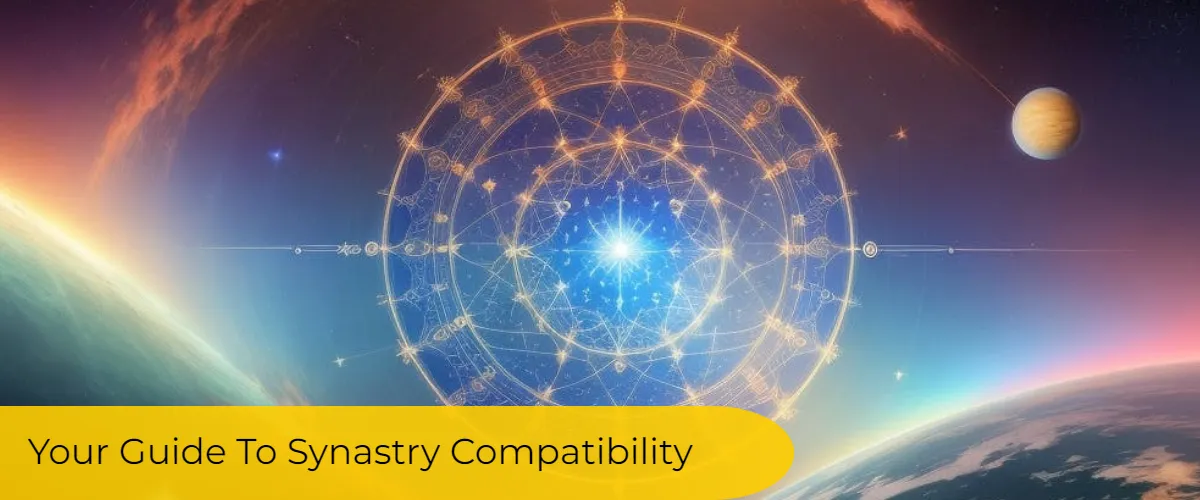
What Is A Synastry Chart In Relationship Astrology?

Recent surveys suggest that nearly 60% of you have glanced at your horoscope at least once in the past year, reflecting an enduring curiosity about how celestial bodies might influence your personal experiences.
But beyond the daily predictions that you might casually encounter, lies a more intricate and telling astrological analysis known as a synastry chart. This tool in relationship astrology offers you a unique lens through which to view the dynamics between you and a partner, mapping out the interplay of planets at the time of your births.
It reveals the cosmic chemistry, highlighting areas of harmony and potential friction. You’re probably wondering how celestial alignments can give insight into your personal relationships and whether the stars might actually be aligning for you and someone special. The answers lie within the constructs of a synastry chart, an ancient practice that might just shed light on the complexities of your connections.
In this article, our astrologer Bella Martin will investigate what makes up a synastry chart in relationship astrology. We'll explore how these charts work and explain everything you need to know about interpreting the information they provide. So grab your partner’s birthdate (and maybe even yours too) – we’re going on an astrological journey together!
Understanding Synastry Charts
To grasp the complexities of synastry charts, it’s essential to recognize that they represent the intricate astrological dynamics between two individuals’ birth charts. This analytical tool explores into how the planets and points in your chart interact with someone else’s, revealing potential strengths and challenges in a relationship.
Planetary dignities play a crucial role here- they assess how comfortably a planet is positioned within a sign, which in turn influences its ability to express its qualities in your relationship.
For instance, if your Venus is in Libra and your partner’s Mars is in Capricorn, Venus is ‘dignified’ because it’s in the sign it rules, suggesting a natural flow in affection and social graces. On the other hand, Mars might express its drive and ambition more reservedly or strategically due to Capricorn’s disciplined influence.
Zodiac compatibility surfaces when analyzing the aspects, or angular relationships, between planets from both charts. Sextiles and trines often denote ease and harmony, whereas squares and oppositions can indicate areas requiring work and compromise.
Understanding these interactions is vital, empowering you to navigate the relationship with awareness and intention. Freedom lies in the knowledge of these celestial undercurrents, enabling you to make informed choices in your personal connections.
Key Components Of Synastry
Several key components form the bedrock of synastry, each offering insight into the myriad ways your planetary positions interact with another’s, shaping the unique dynamics of your relationship. As you explore this intricate analysis, you’re not just exploring zodiac compatibility; you’re unraveling the complex web of celestial influences that govern your interactions.
At the core of synastry lies the comparison of two natal charts. This involves a meticulous examination of each planet’s location at the time of your births. You’ll scrutinize the angles—conjunctions, sextiles, squares, trines, and oppositions—between your planets and theirs. These aspects reveal the flow of energy between you, be it harmonious or challenging.
The Sun and Moon are pivotal, symbolizing your core identity and emotional needs, respectively. When someone’s Sun falls into a particular house in your chart, it illuminates that area of your life. Conversely, their Moon in your chart can indicate how well your emotional landscapes mesh.
Mercury’s placement speaks to communication styles, Venus to love and value systems, Mars to desire and conflict resolution. Outer planets like Jupiter and Saturn contribute long-term growth and structure to the equation.
Understanding these components grants you the liberty to navigate your relationships with greater autonomy and clarity.
Interpreting Planetary Aspects
Understanding the planetary aspects in your synastry chart can reveal the underlying dynamics of your interactions, highlighting areas of potential harmony and friction within your relationship. Each aspect forms a specific angle that brings out unique qualities in the planets involved. You must consider not just the aspect itself but also the planetary orbs, which are the degrees of allowance for the aspect to still be effective. Tighter orbs indicate stronger, more pronounced influences.
The aspect patterns formed by these interactions can be complex, but they offer a technical blueprint of the energetic exchanges between you and your partner. These patterns help you grasp the subtleties of your connection, giving you the insight to navigate the relationship with a greater sense of freedom and autonomy.
Here’s a table to elucidate some common aspects:
| Aspect | Angle (Degrees) | Interpretation |
|---|---|---|
| Conjunction | 0-10 | Intensity, fusion of energies |
| Sextile | 60-6 | Harmony, supportive interaction |
| Square | 90-8 | Challenge, dynamic tension |
| Trine | 120-8 | Flow, natural compatibility |
| Opposition | 180-10 | Balance, polarizing forces |
Analyzing the nuances of these aspects demands a technical approach, recognizing the intricate dance of push and pull that defines your shared path.
The Role Of The Sun And Moon
Often, the positions of the Sun and Moon in a synastry chart illuminate core compatibilities and emotional undercurrents between partners. You’ll find that the Sun symbolizes your Solar identity — the essence of who you are, your ego, and your personal sense of self. The Moon, on the other hand, reflects your Lunar compatibility - the instinctual, emotional landscape you navigate within relationships.
When analyzing the Sun and Moon in your synastry chart, consider the following:
Conjunctions: When one person’s Sun or Moon is in the same sign as the other’s, it suggests a strong, innate connection.
Trines and Sextiles: These harmonious aspects indicate ease and support in understanding each other’s core identity and emotional needs.
Squares and Oppositions: Challenging aspects that can lead to growth if both partners are willing to work through differences.
Inter-aspects: The aspects between one person’s Sun and the other’s Moon are particularly telling of the relationship’s potential for emotional fulfillment.
House placements: The houses in which the Sun and Moon fall can reveal the life areas most impacted by the relationship.
Your synastry chart isn’t a fixed destiny but a map of potential. You’re free to navigate it with conscious choice, using the stars as guides to mutual understanding and growth.
Analyzing House Overlays
Peering into house overlays offers a nuanced view of how your planets influence each partner’s experience within various life domains. This analytical lens dissects the subtle interplay between your planetary positions and the twelve astrological houses of your partner’s chart, shaping both attraction dynamics and communication patterns.
When your planets fall into your partner’s first house, for instance, you’re often seen as a direct extension of their identity, potentially enhancing the magnetic pull between you. Conversely, your planets in their seventh house can illuminate the dynamics of partnership and negotiation, highlighting the balance of give-and-take in your relationship.
The intricacies of house overlays extend beyond just attraction. Your Mercury in your partner’s third house can significantly streamline communication patterns, enabling a free exchange of thoughts and ideas. This placement often denotes a mental rapport that fosters an open dialogue.
However, not all overlays are harmonious. A Saturn overlay in the fourth house might introduce a sobering effect on matters of home and emotional security, demanding a mature approach to these sensitive areas.
In essence, analyzing house overlays is akin to decoding a complex dance of planetary energies across the astrological stage of your relationship. It’s a technical exercise that can liberate your understanding of how you and your partner move through life together.
Challenging Aspects And Growth
While house overlays reveal the fabric of daily interactions, it’s the challenging aspects that test and ultimately strengthen the bonds of a relationship through necessary growth and adaptation. These aspects can lead to friction, but they’re crucial for emotional development and conflict resolution. Embracing these challenges allows you to move towards a more liberated and authentic connection.
Consider these key points in challenging aspects:
Square aspects create tension and dynamic struggles, demanding action to resolve and harmonize differences.
Oppositions reflect polarized energies that need integration, pushing you towards compromise and understanding.
Quincunx aspects introduce awkwardness, requiring adjustments and fostering resilience in the face of discomfort.
Hard aspects between Mars and Venus can spark passion but also conflict, necessitating a balance between desire and harmony.
Saturn hard aspects may feel restrictive, but they teach patience and fortify commitments through perseverance.
Synthesizing The Synastry Reading
Synthesizing a synastry reading requires you to integrate the complex tapestry of aspects and house overlays into a coherent narrative about the relationship’s potential dynamics. To adeptly navigate this synthesis, you’ll look into the subtleties of planetary dominance and zodiac compatibility, weighing their influence with discernment.
Consider the planets that wield the most influence—those with the strongest aspects or that rule key houses in the chart. Their energies will dictate much of the relationship’s ebb and flow. For instance, a dominant Venus might suggest a bond with a strong love language, while a prominent Mars could imply passionate, albeit potentially contentious, interactions.
Zodiac compatibility also plays a critical role. It’s not just about Sun signs; you must scrutinize the Moon, Venus, Mars, and beyond. How do these planetary placements harmonize or clash within the signs? A Mars in Aries paired with a Mars in Libra could indicate a push-pull dynamic, challenging partners to find a balance between assertiveness and compromise.
Ultimately, you’re seeking a balance between individual autonomy and shared growth. This synthesis isn’t about predicting fate but empowering you with insights to navigate your shared journey with wisdom and intentionality.
Conclusion
In the cosmic dance of relationships, your synastry chart is the choreographer, intricately weaving your planetary positions into a duet of destiny. By analyzing the ebb and flow of your celestial energies, you’ll gain profound insights into the dynamics at play.
Remember, even the most challenging aspects serve as catalysts for growth, pushing you to harmonize your steps. Embrace the complexity of your synastry reading; it’s the blueprint to understanding the architecture of your togetherness.
Thank you for reading, we at playwithlife.org are always excited when one of our posts is able to provide useful information on a topic like this!

